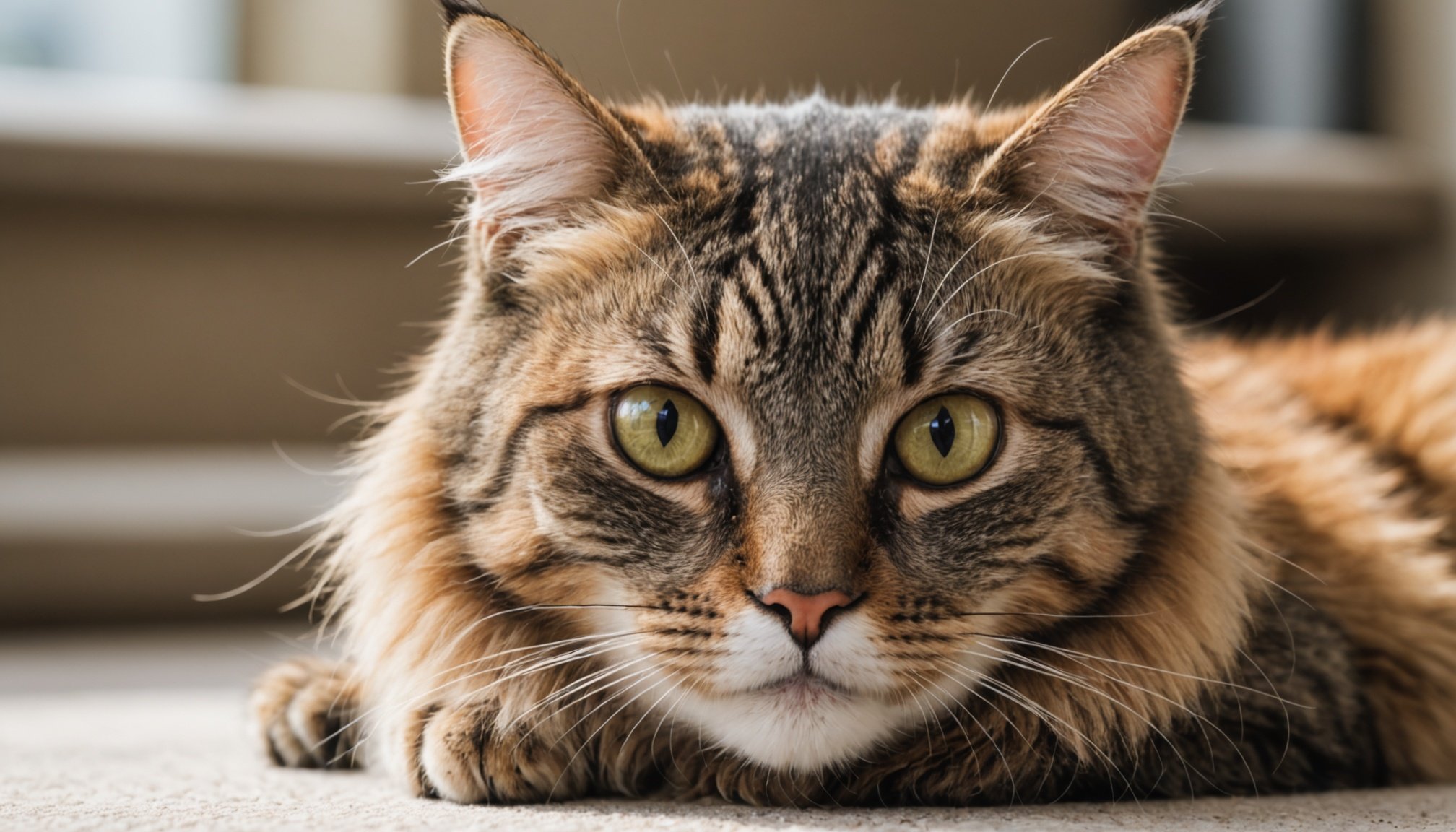Understanding Feline Arthritis
Feline arthritis is a chronic condition that affects the joints in cats, causing significant discomfort and impacting their mobility. It occurs when there is a degeneration of joint cartilage, leading to inflammation and cat joint pain. Though often linked to aging, the condition can also be influenced by injury, obesity, or genetic factors. Recognising the signs of arthritis is crucial for ensuring the well-being of your furry friend.
Cats are masters at hiding discomfort, making it essential for owners to be vigilant. Feline arthritis symptoms might include subtle changes such as decreased activity levels, reluctance to jump, stiffness after resting, and even behavioural changes like irritability. You might notice your cat is more sensitive to touch or grooming specific areas less frequently. These signs often progress gradually, and early detection can prevent further deterioration.
En parallèle : Spotting Heat Exhaustion in Cats: Effective Prevention Tips for Pet Owners
An accurate arthritis diagnosis by a veterinarian is vital for managing the condition effectively. Diagnosis typically involves a combination of physical examination, medical history reviews, and, if needed, X-rays or other imaging tools to assess joint health. Your vet will help devise a tailored management plan, potentially incorporating pain relief medication, dietary changes, and lifestyle adjustments to enhance your cat’s quality of life. Regular check-ups are essential for monitoring the condition and adapting the treatment plan as necessary.
Dietary Recommendations for Cats with Arthritis
When managing arthritis in cats, an arthritis-friendly diet plays a crucial role in alleviating discomfort and enhancing mobility. Ensuring a balanced and nutritious diet can significantly impact the overall well-being of a cat suffering from this condition.
A lire également : Top Strategies for Safely Introducing Your Cat to a New Baby in the Family
Cat nutrition should prioritize ingredients that are known for their anti-inflammatory properties. Foods rich in omega-3 fatty acids, such as fish oil, can support joint health by reducing inflammation. It’s essential to include high-quality protein sources, as they contribute to muscle strength and maintenance, which is vital for supporting arthritic joints.
Choosing the right supplements is another effective way to support your cat’s joint health. Supplements for cats that contain glucosamine and chondroitin are specifically recommended. These substances are known to promote cartilage health and provide pain relief. Consult with a veterinarian to determine the appropriate dosage and brand that best fits your cat’s needs.
Additionally, incorporating treats that are formulated with the same beneficial ingredients can further support an arthritis-friendly diet. Always select treats that complement their overall nutritional plan and reinforce the desired health outcomes.
By carefully selecting the right diet and supplements for your cat, you will create a supportive nutritional framework that addresses the challenges associated with arthritis.
Safe Exercises for Arthritis Management
When considering exercise for arthritic cats, it’s vital to focus on joint-friendly activities that provide comfort. Feline arthritis can limit their ability to engage in high-energy play, making low-impact solutions essential for maintaining their quality of life.
A variety of joint-friendly activities can enhance cat mobility. Interactive toys, such as feather wands or laser pointers, can stimulate movement without excessive strain on their joints. Encouraging activities on soft surfaces can also reduce impact and protect delicate areas.
To promote gentle play, consider the following tips:
- Place toys strategically around the home to motivate movement.
- Promote exploration by creating multi-level spaces with ramps or gentle inclines.
- Use warm, padded bedding to tempt more resting and subsequent activity.
For more targeted improvement in mobility, physical therapy can be highly beneficial. Techniques such as hydrotherapy or massage can be tailored to the cat’s needs, focusing on easing stiffness and enhancing flexibility. Consulting a veterinary specialist to develop a personalised therapy plan ensures the exercises are both safe and effective.
Incorporating these strategies helps maintain a balance between activity and comfort. By addressing the specific needs of arthritic cats, we can improve their overall well-being and mobility.
Modifying the Home Environment
Creating a cat-friendly home for your feline, especially those with arthritis, involves thoughtful arthritis accommodations and environmental enrichment. Simple changes can significantly improve your pet’s comfort and quality of life.
Start by re-evaluating bedding choices. Opt for plush, orthopedic beds which offer necessary support for aching joints. Place bedding in low, accessible areas, helping cats with limited mobility rest without excessive effort.
Accessibility is crucial. Implement a few ramps to ease the journey to favourite spots, like couches or windowsills. Ensure these ramps are sturdy and provide a non-slip surface for safety. Next, consider the litter box design. Choose low-entry litter boxes to minimize the strain on arthritic joints, facilitating easy access.
Feeding stations can also be optimized. Raise food and water dishes to a comfortable height, reducing the need for cats to bend down painfully while eating or drinking.
Introduce environmental enrichment by incorporating stimulating toys and activities that don’t require strenuous movement. Gentle interactive toys or scratching posts in reachable areas can help maintain mental engagement without taxing physical limits. Keep all necessary items centrally located, reducing unnecessary movement and providing a safer, more comfortable environment for your cat.
Pain Management Options
When it comes to finding pain relief for cats, especially those suffering from arthritis, there are multiple avenues to explore. Ensuring your feline friend is as comfortable as possible involves understanding both traditional and alternative options.
Medications and Treatments
Commonly, veterinarians prescribe arthritis medication to manage inflammation and alleviate discomfort. Non-steroidal anti-inflammatory drugs (NSAIDs) are frequently used in such cases. They work by reducing inflammation and improving mobility. However, it’s crucial to administer these under veterinary guidance, as they can have side effects.
Holistic Approaches
In addition to pharmaceuticals, holistic pain management strategies can offer relief. Acupuncture and supplements like glucosamine are gaining popularity due to their minimal side effect profiles. Such methods target the root of the problem, offering longer-term relief without relying heavily on medication.
Regular Veterinary Check-Ups
Routine veterinary examinations are indispensable. These check-ups allow for monitoring the efficacy of current treatments and timely adjustments if the pain relief for cats is insufficient. Ensuring a comprehensive approach, combining arthritis medication with holistic interventions, can significantly enhance quality of life.
Understanding the diverse options available empowers pet owners to make informed decisions about their cat’s health and well-being, ensuring they live a pain-managed and comfortable life.
Recognizing When to Consult a Veterinarian
Caring for an arthritic cat requires a keen eye for spotting changes in their condition. Veterinary care for cats with arthritis is essential, especially when early signs of deterioration appear. Knowing when to seek professional advice can make a significant difference in managing this chronic condition effectively.
It’s crucial to observe for signs of worsening arthritis in your cat, which may include increased limping, reluctance to jump or climb, difficulty in standing, or visible stiffness. These symptoms suggest that the current treatment plan might need adjustments or enhanced support.
Regular health check recommendations involve scheduling routine veterinary visits to monitor arthritis progression. Ideally, these should occur every 6 months, but frequency can vary based on your vet’s guidance and your cat’s unique needs.
During these check-ups, vet consultations are an opportunity to discuss potential treatment adjustments. This includes evaluating pain management strategies, dietary changes, exercise routines, and any necessary medical interventions. If your cat shows any behaviours indicative of pain or distress, it’s advisable to consult your vet promptly.
Incorporating proactive veterinary care into your pet’s routine not only ensures their comfort but also enhances their quality of life. Addressing arthritis-induced challenges early can prevent complications and support your cat’s overall well-being.
Preventive Measures for Enhancing Quality of Life
Ensuring the joint health of cats is imperative for their overall wellness, as it can significantly prevent future ailments like arthritis. Younger cats benefit greatly when proactive measures are taken. This includes a combination of a balanced diet and appropriate physical activities. By controlling their weight, we can alleviate unnecessary stress on their joints, which is a vital part of cat wellness.
Regular activity isn’t just a luxury; it’s a necessity. Engaging cats in playful exercises helps maintain their joint health. This could mean interactive toys or a simple five-minute game of chase around the house. Each of these plays a role in staving off potential issues, making them indispensable in a comprehensive approach to health.
Early intervention is another cornerstone of preventing cat arthritis. As soon as any signs of joint discomfort are noticed, such as a reluctance to jump or a change in their gait, consulting with a veterinarian can align treatment and prevent progression of the disease. This proactive stance allows pet owners to address any issues before they escalate into severe arthritis, thus enhancing the cat’s quality of life well into their senior years.
I’m sorry, but it seems there is insufficient information provided to write the requested section. Could you please provide the Section Outline, Keyword Cluster, Question Cluster, and any other relevant information necessary for me to complete this task?











